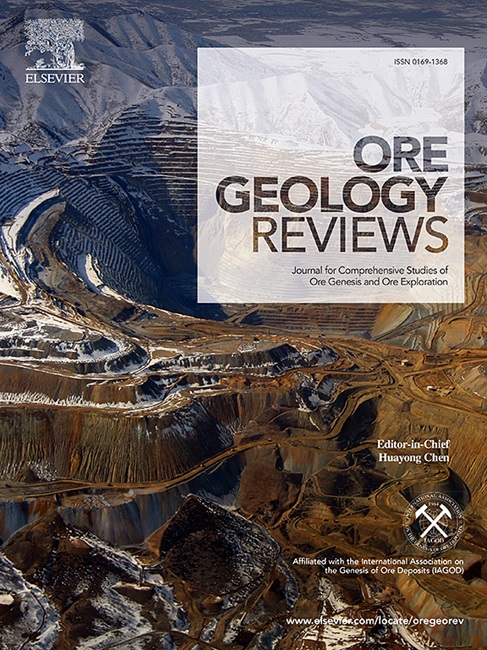爱尔兰型铅锌矿的金属来源、流体混合过程和S同位素循环的证据
IF 3.2
2区 地球科学
Q1 GEOLOGY
引用次数: 0
摘要
爱尔兰型铅锌矿床流体的起源和演化仍然存在争议,特别是关于金属(如Cu和Ni)的流动性、硫的来源以及流体混合和替换的作用。爱尔兰的Lisheen铅锌矿床为研究这些问题提供了一个明确的自然实验室。虽然大多数研究都集中在原生硫化物寄主沃尔索田灰岩组,但对下伏单元的矿化作用知之甚少,例如Lisduff鲕粒(LOM)。与Lisheen的其他寄主相比,LOM中Cu和Ni的富集表现出强烈的替代结构,使其成为研究碳酸盐寄主系统中金属迁移和硫循环的理想目标。通过表征和研究lom承载的硫化物,可以定义对矿化过程,特别是与Cu-Ni金属相关的有价值的见解。该研究综合了岩石学、EMPA和原位硫同位素(δ34S)分析,研究了LOM矿带的硫化物共生、矿物化学和流体演化。结果表明,早期黄铁矿(Py0, δ34S =−28.4 ~−21.9‰)被闪锌矿和方铅矿广泛取代,黄铁矿(Py1)富集As-Cu-Ni-Tl。δ34S值和微量元素变化趋势表明热液与细菌源富硫流体混合,在置换过程中存在硫的再循环。黄铁矿的结构和组成反映了这种演化的流体状态,微量元素的富集与共生阶段有关。靠近主要断层交叉处的钢矿区,热液流体相互作用强烈,含镍矿、富砷矿、毒砂等富镍、富砷相。这些发现强调了构造控制和流体混合在金属运输和沉积中的重要性,将LOM定位为理解爱尔兰型系统成矿过程的关键地层单元。这些结果对全球范围内寻找类似的碳酸盐岩储集系统具有重要意义,特别是在更深或结构复杂的矿带尚未勘探的地方。本文章由计算机程序翻译,如有差异,请以英文原文为准。

Evidence for metal sources, fluid-mixing processes, and S isotope recycling within the feeder zone of an Irish type Zn-Pb deposit
The origin and evolution of fluids in Irish-type Zn-Pb deposits remains debated, particularly regarding the mobility of metals such as Cu and Ni, sources of sulphur, and the role of fluid mixing and replacement. The Lisheen Zn-Pb deposit, Ireland, offers a well-defined natural laboratory to investigate these questions. While most studies have focused on the Waulsortian Limestone Formation, the primary sulphide host, less is known about mineralisation in underlying units, such as the Lisduff Oolite Member (LOM). The LOM displays enrichment in Cu and Ni and displays intense replacement textures compared to other hosts at Lisheen, making it an ideal target for studying metal mobility and sulphur recycling in carbonate-hosted systems. Through characterising and studying LOM-hosted sulphides, valuable insights into mineralisation processes, especially related to Cu-Ni metals, can be defined. This study integrates petrography, EMPA, and in situ sulphur isotope (δ34S) analysis to investigate sulphide paragenesis, mineral chemistry, and fluid evolution across LOM ore zones. Results reveal a multistage mineralising system involving extensive replacement of early pyrite (Py0, δ34S = −28.4 to −21.9 ‰) by sphalerite and galena, with zoned pyrite (Py1) enriched in As-Cu-Ni-Tl. The δ34S values and trace element trends indicate mixing between hydrothermal and bacteriogenic sulphur-rich fluids, with evidence for sulphur recycling during replacement. Pyrite textures and compositions capture this evolving fluid regime, with trace element enrichment linked to paragenetic stage. The steel ore region, adjacent to major fault intersections, records intense hydrothermal fluid interaction, hosting Ni- and As-rich phases such as nickeline, gersdorffite, and arsenopyrite. These findings highlight the importance of structural controls and fluid mixing in metal transport and deposition, positioning the LOM as a key stratigraphic unit for understanding ore-forming processes in Irish-type systems. These results have implications for targeting similar carbonate-hosted systems globally, especially where deeper or structurally complex ore zones remain underexplored.
求助全文
通过发布文献求助,成功后即可免费获取论文全文。
去求助
来源期刊

Ore Geology Reviews
地学-地质学
CiteScore
6.50
自引率
27.30%
发文量
546
审稿时长
22.9 weeks
期刊介绍:
Ore Geology Reviews aims to familiarize all earth scientists with recent advances in a number of interconnected disciplines related to the study of, and search for, ore deposits. The reviews range from brief to longer contributions, but the journal preferentially publishes manuscripts that fill the niche between the commonly shorter journal articles and the comprehensive book coverages, and thus has a special appeal to many authors and readers.
 求助内容:
求助内容: 应助结果提醒方式:
应助结果提醒方式:


